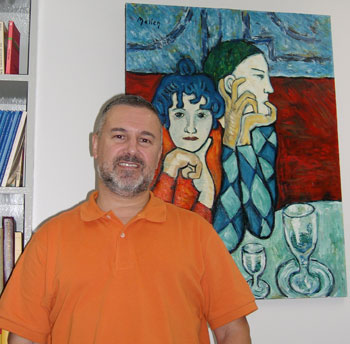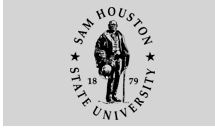Professor Brings 'Picasso Project' To SHSU
 |
Enrique Mallén, professor in the
foreign languages department and director of the Online
Picasso Project, studies Pablo Picasso by recreating
his work. Mallén's copy of Picasso's "The Two Saltimbanques"
hangs in his office. |
In a world where you can type the words “Pablo Picasso”
into Google and get more than 3.5 million hits, it’s
hard to imagine a time when typing those same words into an
Internet browser would return only one result.
But that was the world that existed when SHSU foreign languages
professor Enrique Mallén founded the Online Picasso Project
to document his research information for the art history classes
he taught at Texas A&M in 1997.
“You have to understand that in 1997, the Internet was
still kind of new; 1995 is really when it took off,”
he said. “In 1997, to my surprise, there was one Web
site on Picasso, and it was very, very limited.
“One of the reasons that I did it was because I wanted
to have a Web site on such an important artist in Spanish
art,” he said.
As the Internet began to grow and his classroom became more
and more prepared to handle the phenomenon, the project and
its popularity soared.
“The response was overwhelming,” he said. “That
was one of the things that blew my mind. When the project
started growing, the response was tremendous, and people were
so thankful for this resource.”
Using his students as researchers, as well as the information
he was collecting for the several books he wrote on the artist,
they began compiling data to meet the demands of museums,
galleries and scholars, including Mallén himself.
Today, Mallén’s Online Picasso Project chronicles more
than 13,300 of the Spanish artist’s 50,000 works, including
thousands of articles, work and exhibition reviews and even
plays and poetry, as Picasso was a “prolific writer”
as well, Mallén said.
Web site perusers can search by year, museum name or city
to find high-resolution pictures of all of Picasso’s
catalogued works, where they are located, the medium of the
work (such as oil on canvas) and the dimensions, among other
information.
“Not just a Web site,” the project uses “all
the innovations of computer science to make a project that
is tailored toward the user,” Mallén said.
“It’s a project that changes according to who
is using it,” he said. “You have scholars, for
example, looking for specific information, or critical information,
about Picasso’s work; you also have galleries that go
in there looking for some data, some work and where it might
be located or if it was auctioned recently; or you might have
museums trying to get some information on borrowing to mount
an exhibition.”
One such museum was El Prado, one of the most prestigious
museums in Spain, which contacted him about a year and a half
ago seeking information.
Recently, Mallen’s project has caught the attention
of international media, having been featured on PBS and in
the British “The Guardian” newspaper, in which
writer Ana Finel Honigman said, “the artist would surely
approve of this most comprehensive and extensive Web site
devoted entirely to him.”
Like Picasso, Mallén is both a Spaniard and a painter. His
goal for the project is to educate his students and the public
about “one of the most important artists in the history
of art.
“One of the things that I really love about the project
is that we professors sometimes become isolated from the community
because we concentrate on our research and the classes that
we teach, but people out there have other ways of doing thing
and other interests, so the project keeps me in touch with
other realities."
The linguist, who speaks Spanish, German and English, came
to SHSU this fall and intends on having both the students
here continue with the project as well as Texas A&M students
who are using it both for and as the topic of their dissertations.
Both universities’ computer science programs will also
maintain the Web site and update it with Mallén’s programming
ideas.
“One of the wonderful things about the Picasso Project
that I really love is this idea of collaboration between different
disciplines,” he said. “Unfortunately, most of
them (the computer scientists) have no interest in art, but
they find it to be very challenging when I present to them
how to do certain things.”
The challenges presented in interrelating the various aspects
of Picasso’s works, as well as adding his additional
almost 37,000 works to the Web site, will make the project
an “infinite” one, according to Mallén.
“The thing with the project is that the more information
you put in, the more challenging it becomes because everything
is interrelated. The works are related to biographical facts,
critical commentary,” he said. “When we started,
7,000 was hard to relate, but 13,000 is much harder to relate.
When you get to 30,000, it’s going to be even harder
to manipulate all of this information.
“So even if we got to the 50,000, say in the next 20
years, more challenges are going to be presented,” Mallén said. “It’s not just accumulation of the data,
but manipulation of the data as well. I expect this project
to continue way, way after I’m dead.”
The Online Picasso Project is located at http://picasso.tamu.edu/picasso/.
—END—
SHSU Media Contact: Jennifer
Gauntt
Sept. 6, 2007
Please send comments, corrections, news tips to Today@Sam.edu.
|


